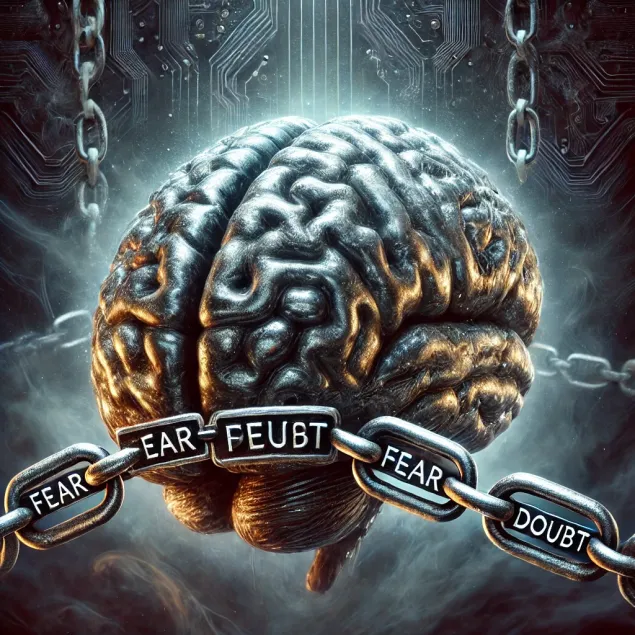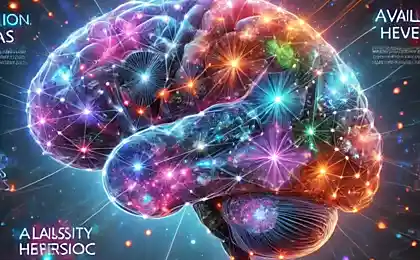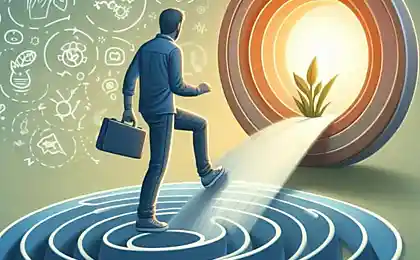158
Comfort Zone Syndrome: 9 Reasons Why the Brain Resists Change
“Why are you running away from yourself: Neurological and psychological growth traps
439052
The Evolution Paradox: Why Development Causes Pain
A study by the University of Cambridge (2023) found that 89% of people consciously avoid challenges, even knowing their benefits. Neuroscientists explain this as a conflict between ancient brain structures and the neocortex. How do you turn an inner saboteur into an ally? The answer lies in understanding the 9 key mechanisms of resistance.
1. Energy saving: saving resources at all costs

The brain consumes 20% of the body’s energy, although it weighs only 2% of its mass. A Nature Neuroscience study (2021) found that new tasks activate the prefrontal cortex, increasing glucose consumption by 35%. Evolution has programmed us to find the path of least resistance, hence the craving for routine.
How to fool instinct:
2. The Dunning-Kruger Effect: Blindness of Incompetence
Psychologists from Cornell University have shown that 80% of people overestimate their skills in the initial stages of learning. This leads to a “cognitive collapse” when confronted with real-world challenges. The solution is a conscious transition from “I already know everything” to “I have something to learn.”
3. Neuroplasticity vs. routine: The battle of habits
Each repeated thought forms the myelin sheath of neurons. A study by MIT (2022) showed that it takes 3 times more effort to change established behavior than to form it. But the good news is that after 21 days of conscious practice, the brain begins to perceive new things as safe.
4. Impostor syndrome: the ghosts of past success

68% of highly educated people, according to the Journal of Behavioral Science, consider their achievements to be accidental. Neuropsychologists attribute this to the hypertrophied activity of the anterior cingulate cortex, which is responsible for analyzing errors.
5. Social Thermostat: Fear of Standing Out
Leon Festinger’s theory of social comparison explains that we unconsciously adapt to our environment. The Stanford experiment (2020) showed that participants were 40% less likely to show initiative in groups with passive members. The way out is to create a “growth microenvironment” by connecting with inspiring people.
6. The Adrenaline Trap: Crisis Addiction
A paradox revealed at Harvard Business School: 55% of executives admit to only being effective on deadlines. The reason is the habit of cortisol swings that stimulate short-term motivation. The solution is to move from crisis management to conscious planning.
7. Disruption Theory: Fear of Losing Identity
Sociologist Erwin Hoffman proved that we cling to the old selves as a lifeline. Neuroimaging shows that thoughts of dramatic changes activate the islet lobe of the brain, causing physical discomfort. Overcoming through the technique of “small transformations.”
8. Responsibility Hypertrophy: What if I can’t? ?
A study by the Anxiety and Depression Association of America found that 62% of people give up opportunities for fear of the consequences of success. Psychologists recommend “paradoxical intention”—consciously modeling the worst-case scenario to reduce anxiety.
9. Meta Skill Deficiency: How to Learn
According to the World Economic Forum, 73% of adults do not know the techniques of mindful learning. Neuroplasticity requires not effort, but strategy: interval repetition, cross-contextual application of knowledge, reflective practices.
Conclusion: The Art of Conscious Discomfort
As neuropsychologist Dr. Rick Hanson said, “The brain is like plasticine – what you consciously sculpt today will become your nature tomorrow.” Every challenge is not a test, but an opportunity to reprogram neural pathways. The growth zone begins where comfort ends, but courage does not end.
439052
The Evolution Paradox: Why Development Causes Pain
A study by the University of Cambridge (2023) found that 89% of people consciously avoid challenges, even knowing their benefits. Neuroscientists explain this as a conflict between ancient brain structures and the neocortex. How do you turn an inner saboteur into an ally? The answer lies in understanding the 9 key mechanisms of resistance.
1. Energy saving: saving resources at all costs

The brain consumes 20% of the body’s energy, although it weighs only 2% of its mass. A Nature Neuroscience study (2021) found that new tasks activate the prefrontal cortex, increasing glucose consumption by 35%. Evolution has programmed us to find the path of least resistance, hence the craving for routine.
How to fool instinct:
- Technique "5 minutes" - start action for a short time
- Linking new tasks to automatic rituals
2. The Dunning-Kruger Effect: Blindness of Incompetence
Psychologists from Cornell University have shown that 80% of people overestimate their skills in the initial stages of learning. This leads to a “cognitive collapse” when confronted with real-world challenges. The solution is a conscious transition from “I already know everything” to “I have something to learn.”
3. Neuroplasticity vs. routine: The battle of habits
Each repeated thought forms the myelin sheath of neurons. A study by MIT (2022) showed that it takes 3 times more effort to change established behavior than to form it. But the good news is that after 21 days of conscious practice, the brain begins to perceive new things as safe.
4. Impostor syndrome: the ghosts of past success

68% of highly educated people, according to the Journal of Behavioral Science, consider their achievements to be accidental. Neuropsychologists attribute this to the hypertrophied activity of the anterior cingulate cortex, which is responsible for analyzing errors.
5. Social Thermostat: Fear of Standing Out
Leon Festinger’s theory of social comparison explains that we unconsciously adapt to our environment. The Stanford experiment (2020) showed that participants were 40% less likely to show initiative in groups with passive members. The way out is to create a “growth microenvironment” by connecting with inspiring people.
6. The Adrenaline Trap: Crisis Addiction
A paradox revealed at Harvard Business School: 55% of executives admit to only being effective on deadlines. The reason is the habit of cortisol swings that stimulate short-term motivation. The solution is to move from crisis management to conscious planning.
7. Disruption Theory: Fear of Losing Identity
Sociologist Erwin Hoffman proved that we cling to the old selves as a lifeline. Neuroimaging shows that thoughts of dramatic changes activate the islet lobe of the brain, causing physical discomfort. Overcoming through the technique of “small transformations.”
8. Responsibility Hypertrophy: What if I can’t? ?
A study by the Anxiety and Depression Association of America found that 62% of people give up opportunities for fear of the consequences of success. Psychologists recommend “paradoxical intention”—consciously modeling the worst-case scenario to reduce anxiety.
9. Meta Skill Deficiency: How to Learn
According to the World Economic Forum, 73% of adults do not know the techniques of mindful learning. Neuroplasticity requires not effort, but strategy: interval repetition, cross-contextual application of knowledge, reflective practices.
Conclusion: The Art of Conscious Discomfort
As neuropsychologist Dr. Rick Hanson said, “The brain is like plasticine – what you consciously sculpt today will become your nature tomorrow.” Every challenge is not a test, but an opportunity to reprogram neural pathways. The growth zone begins where comfort ends, but courage does not end.
Invisible Cracks: 9 Causes of Insecurity That Are Undermining Your Relationship
22 Movies That Will Reboot Your Mindset: How Movies Help You Find Yourself























